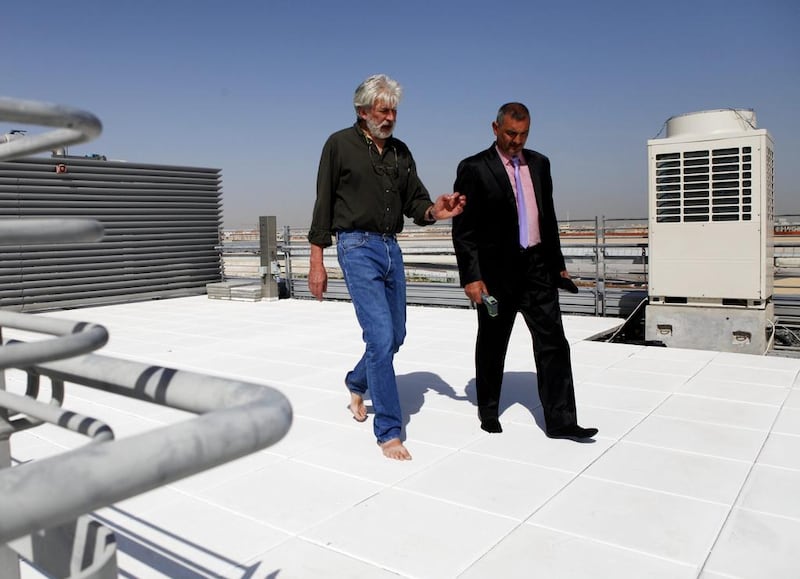On hot, summer days, the last place you would want to be is up on a roof – especially without footwear on.
But scientists at Masdar Institute are testing a paint that cools so much you can remove your shoes and walk around on any surface covered with it.
They are hoping the cool paint will be used throughout Abu Dhabi and the UAE, believing it could significantly reduce the environmental cost of running air-conditioning units.
Its developers, Watergy International Group, claim the paint could reduce a building’s surface temperature by 20 per cent.
This in turn would reduce the cooling load of the building as a whole, energy consumption and carbon dioxide production.
The technology was tested on a 197-square-metre area of the roof at the Masdar field station, where Watergy workers painted a third of the area with gray cool paint, which matched the original colour of the concrete, a third was painted white, while the remainder of open roof area was left uncoated. Stepping on to the cool painted area, everyone took their shoes off under the glaring sun and started strolling around the cool roof.
The difference between the painted and non-painted areas was immediately noticeable.
Peter Armstrong, associate professor of mechanical engineering at Masdar Institute, said that the white paint is the coolest, but based on architectural requests, the paint could be provided in other colours, such as grey and black.
“It is best to have white on the roof because no one can see it up there,” he said.
Measuring the temperature on the unpainted area at 9.30am on a toasty Abu Dhabi morning, the reading was 46.6°C. Moving to the coated area it was 24.9°C.
Prof Armstrong believes it is not only buildings that could benefit.
He suggested painting the streets with it as “the cooling load of the AC in the car will be less”.
He explained that when a car’s air conditioning is turned up, while the car might be nice and chilled, you are adding to the heat of the street and the surrounding environment.
The secret to the cooling is titanium dioxide, a chemical used in sunscreens because of its excellent reflective qualities.
Prof Armstrong says the paint would have more dramatic effects on buildings with poor insulation.
“A typical villa with concrete or block walls with no insulation benefits the most from this paint – which is the case in most of Abu Dhabi,” he said.
Another useful way to take advantage of the paint is to apply it to AC units on roofs of buildings.
“Villas would benefit greatly. In a typical villa the AC unit is up on the roof so when you limit the heat on the roof you improve the performance of the AC because now where the AC is, it is a lower temperature,” he said. “The higher the temperature is where AC is trying to reject the heat the lower the performance.”
Industrial areas and warehouses could also benefit greatly.
“For example, car shops have fans in their warehouses. Let’s say the fan is sending down air at 40°C,” said Wamid Zori, managing director of Watergy. “So imagine the impact if we can get it down to 30°C.”
Cool paint costs as much as any good-quality paint, “so it is not so expensive, yet worth the other savings”, Mr Zori said.
The paint has already been tested on a hangar roof in Sharjah and a supermarket in Milan, Italy with positive results.
Meanwhile, Watergy has signed a letter of intent with Masdar worth Dh10 million to test the paint in two 50,000-square-metre areas of Abu Dhabi.
Prof Armstrong is keen to get started painting straight away.
hdajani@thenational.ae
* The article has been amended since it was first published.






